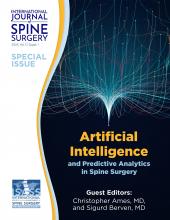An evidence-based approach to the management of patients with spinal disorders is complex, and it requires consideration of several factors, including spinal pathology, anatomy, patient comorbidities, and goals of both the patient and the surgeon. The presence of high variation in surgical rates and surgical approaches is a reflection of the heterogeneity of clinical presentations and of the absence of an evidence-based approach to guide care. Techniques of artificial intelligence, including machine learning and convoluted neural networks, enable integration of data from large datasets, including clinical studies, patient-specific predictor variables, and observed probabilities to guide an evidence-based approach to care that is specific to the individual patients. The application of techniques of artificial intelligence has great potential to improve informed choice for patients and surgeons and to improve the appropriate use of care for patients with spinal disorders. The purpose of this special edition of the International Journal of Spine Surgery is to provide an overview of the use of artificial intelligence in spine surgery, including present and future applications and limitations.
Use of Machine Learning in Spine Surgery
Machine learning is an artificial intelligence technique that enables software to learn from data and to make predictions or decisions without being explicitly programmed. In spine surgery, machine learning algorithms are trained on large datasets of patient data, imaging studies, and surgical outcomes. The algorithms then use these data to build predictive models that aid surgeons in planning and executing surgical procedures.
This special issue includes 7 articles written by experts who are actively engaged in the application of artificial intelligence across the continuum of care in spine surgery, including preoperative risk stratification and predictive modeling, intraoperative execution and decision-making, and postoperative optimization of recovery, including early identification and treatment of adverse events. The use of artificial intelligence in spine surgery may provide information to guide an evidence-based approach to optimal treatment at each stage of care for patients with spinal disorders.
The issue begins with an article by Young regarding the rapid growth of devices incorporating artificial intelligence in medicine broadly and the potential for a cognitive revolution of spine surgery through the integration of large data in guiding decision-making. The article also describes important concerns regarding the difference between associations and causality when integrating artificial intelligence into the care of the patient. In another article, Browd identifies opportunities for the application of artificial intelligence across the continuum of care, including patient selection, intraoperative decision-making, and outcome prediction. He discusses the importance of physicians understanding the technology for informed application to patient care. In the next article, Habboub et al review the use of artificial intelligence/machine learning algorithms and provide information that may guide patient selection, treatment planning, and prediction of outcomes and complications. The authors describe the practical application of artificial intelligence in spine surgery at the Cleveland Clinic and the University of California, San Francisco.
Four articles discuss the use of artificial intelligence and machine learning for spinal pathologies, including deformities and tumors of the spine. Lombardi and Lehman provide a discussion of current published tools that employ machine learning for spinal deformity populations, including applications for preoperative optimization, risk stratification, and predictive modeling. Pizones et al identify the limitations of present models in accurately predicting applications and complications. The authors discuss the importance of incorporating more variables for improving the accuracy of predictive models in deformity, including metrics that capture frailty, sarcopenia, senescence, and epigenetics. Radiomics encompasses important variables that provide information regarding anatomy, alignment, and space for the neural elements. Daniels et al describe combining radiomics with clinical data and genomics to provide informed decision-making for spinal pathology, including tumors, deformity, and osteoporotic pathology. Kuitjen et al discuss the predictive models under development for spine oncology and emphasize the need for transparent reporting and validation.
The application of artificial intelligence to guide an evidence-based approach to optimal management of individual patients holds great promise to bring precision medicine to patients with spinal disorders. The methods of artificial intelligence enable the incorporation of variables, including disease-specific and patient-specific factors, that may be applied across the continuum of care, including preoperative optimization, intraoperative standardization, and postoperative enhanced recovery. There are important limitations in applying artificial intelligence methodology to the management of spine patients, including concern regarding correlation and causation. Therefore, it is important that the community of physicians and surgeons who care for patients with spinal disorders understands the applications and limitations of this technology in guiding informed choices during this period of cognitive revolution.
Footnotes
Funding The authors received no financial support for the research, authorship, and/or publication of this article.
Declaration of Conflicting Interests The authors report no conflicts of interest in this work.
Disclosures Christopher Ames reports royalties/licenses for Stryker, DePuy Synthes, Next Orthosurgical, Medicrea, Biomet Zimmer Spine, Nuvasive, and K2M; consulting for DePuy Synthes, Medtronic, Medicrea, K2M, Agada Medical, and Carlsmed; leadership or fiduciary roles in ISSG (Executive Committee), Operative Neurosurgery, Neurospine (Editorial Board), Scoliosis Research Society (Safety and Value Committee Chair), and Global Spinal Analytics (Director); research interests in Tital Spine, DePuy Synthes, and ISSG; and grant funding interests in the Scoliosis Research Society. Sigurd Berven reports consulting for Medtronic, Stryker/K2M, Innovasis, Globus Medical, and Integrity Implants; he also receives royalties from Medtronic and Stryker/K2M and has direct stock ownership in Green Sun Medical and Providence.
- This manuscript is generously published free of charge by ISASS, the International Society for the Advancement of Spine Surgery. Copyright © 2023 ISASS. To see more or order reprints or permissions, see http://ijssurgery.com.







